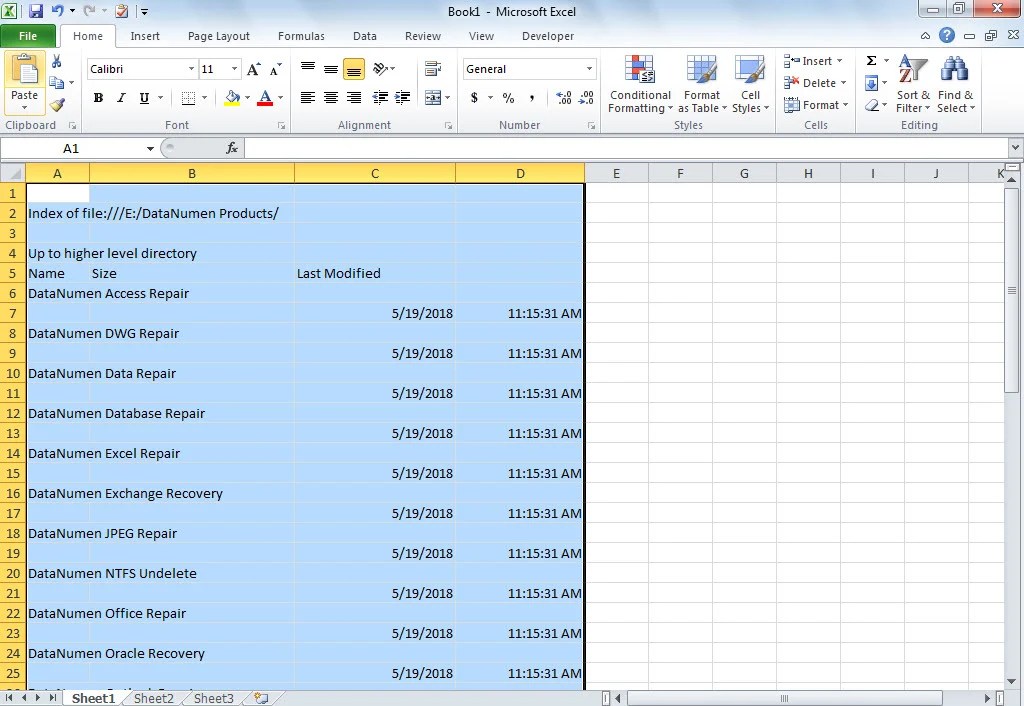5 Simple Methods to Get Excel Sheet Names without VBA

There's no denying that Microsoft Excel is a powerhouse for data manipulation and analysis. Its extensive functionalities allow users to handle vast amounts of data with ease. One common task many Excel users face is listing all the sheet names in a workbook, especially when working with complex files that contain numerous sheets. Traditionally, VBA (Visual Basic for Applications) has been the go-to method for automating tasks like this. However, not everyone is comfortable with or has access to VBA. Here, we'll explore 5 simple methods to get Excel sheet names without using VBA, ensuring that you can manage your workbooks with ease.
Method 1: Use Excel Formulas

Excel offers several formulas that can help you pull sheet names into a list without the need for programming. Here's how:
- Create a new sheet for listing sheet names.
- In cell A1 of this new sheet, enter the following formula:
=MID(CELL("filename",A1),FIND("]",CELL("filename",A1))+1,100)This formula grabs the file name from the current workbook, and with MID, you extract everything after the right square bracket "]", which typically contains the sheet name. - Copy this formula down the column to list all the sheets.
🗒️ Note: This method works on the active sheet. If you want a complete list, you'll need to switch between sheets and update the list.
Method 2: Using Excel's Table of Contents Feature

If your workbook is well-organized, you might have a Table of Contents (TOC) sheet, which can automatically list all sheet names:
- Go to the sheet where you want the TOC, typically named "TOC" or "Index".
- Use the following formula to create a link to each sheet:
=HYPERLINK("#"&SheetName!A1,SheetName)Replace 'SheetName' with the actual names of your sheets.
🗒️ Note: This approach requires manual updates when you add new sheets or rename existing ones.
Method 3: PivotTable for Sheet Listing

PivotTables are versatile for summarizing data, including retrieving sheet names:
- Create a list of sheet names using any of the above methods or simply type them manually.
- Insert a PivotTable:
- Select your list of sheet names.
- Go to Insert > PivotTable.
- In the PivotTable Fields, drag the sheet name field into Rows to display all unique sheet names.
Method 4: Power Query (Get & Transform)

Power Query is Excel's data connection tool, and it can help you retrieve sheet names:
- Go to Data > Get & Transform Data > Get Data > From File > From Workbook.
- Select your Excel file and load it into Power Query Editor.
- In the Query Settings pane, click on "Advanced Editor" and use the following script to get the list of sheets:
let Source = Excel.Workbook(File.Contents("C:\Path\To\Your\File.xlsx"), null, true), Sheets = Source{[Item=Table]}[Data] in SheetsChange the file path as necessary. - Load the resulting table into a new worksheet.
🗒️ Note: This method requires Excel 2013 or later, where Power Query (or Get & Transform) is available.
Method 5: Excel's Name Manager

Another lesser-known but effective method involves using the Name Manager:
- Open the Name Manager (Formulas > Name Manager).
- Create a new defined name. Set its scope to Workbook and its formula to:
=GET.WORKBOOK(1)
- Name this new item something like 'ListSheets'.
- Now, in any cell, use this formula:
=MID(INDEX(ListSheets,ROW(A1)),FIND("]",INDEX(ListSheets,ROW(A1)))+1,255)Copy this formula down to list all sheet names.
In our exploration of 5 simple methods to get Excel sheet names without VBA, we’ve uncovered a variety of techniques suited to different needs and skill levels. From using straightforward formulas to leveraging Excel’s built-in features like Power Query and Name Manager, these methods provide efficient ways to manage and organize your workbook sheets without delving into VBA coding. Each method has its nuances:
- Excel Formulas allow you to dynamically pull sheet names with simple and widely available functions.
- Table of Contents is perfect for workbooks requiring a static overview or index of sheets.
- PivotTable method offers a quick way to summarize and display sheet names if you already have them listed.
- Power Query is ideal for those looking to automate the process with Excel’s data transformation capabilities.
- Name Manager method uses Excel’s internal functionalities to retrieve sheet names using array formulas.
Now that you’re equipped with these methods, you can choose the one that best fits your workflow, your version of Excel, and the complexity of your task. Whether you’re dealing with a small set of sheets or managing extensive, multi-layered workbooks, these techniques simplify the task of listing and navigating your Excel data.
Why do I need to list Excel sheet names?

+
Listing Excel sheet names can help in navigation, especially in complex workbooks. It’s useful for reporting, ensuring data integrity, and for quick referencing.
Can I automate this process if I change sheet names frequently?

+
If you have Excel 2013 or later, using Power Query provides a good level of automation. For those comfortable with VBA, creating a macro to refresh the list can be very effective.
What if I want to link to specific cells in different sheets?

+
You can modify the formulas used in Method 1 and Method 2 to link to specific cells. For instance, change the HYPERLINK formula to reference the specific cell you want to link to in each sheet.



